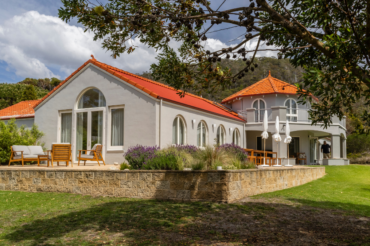
In all cultures, sitting down to feast on a whole roast chicken, stuffed or otherwise, brings about feelings of comfort and abundance.
Until not so long ago, beheading one of the family’s precious chickens for lunch was a luxury only few could afford, and for festive occasions alone.
While a roast chicken has nowadays become an easy casual dinner — something you’d happily eat with your hands, then lick those juices off your fingers and lips — a properly stuffed saffron roast chicken on an Iranian table still holds some prestige and elegance, albeit with the same joyful finger licking. The roast chicken would be like the golden centrepiece of a lavish spread for a gathering, next to trays of rice — of at least two kinds, one simple, perhaps another with broad beans and dill — and possibly lamb stew with zucchini or eggplant.
I am very fond of this filling for roast chicken, not only because of the richness of sweet and sour flavours from the dried fruit, but because it reminds me of the mehmooni (family gatherings) of my aunt, who’s been living in Germany with her family for about 20 years now. She snatched the Azeri-inspired recipe from my grandmother, of course, and, being more daring than my mum in all matters in life, ended up being the only sister who could pull off two stuffed roast chickens to serve to her guests. My mum stuck to her fail-safe khoresh — stews — which gained her the reputation of an excellent cook among family and friends.
For the chicken
1 whole chicken, gutted, about 1.8 kg
11/2 tablespoons salt
1 lemon, halved
For the stuffing
1 cup prunes, pitted
1/2 cup dried apricots, halved
2/3 cup dried barberries or cranberries
30g butter
2/3 cup walnuts, coarsely chopped
⅓ cup golden sultanas (optional)
1 teaspoon sugar (if using barberries)
2 tablespoons golden onion (see below)
2 tablespoons saffron infusion (see p70)
1/2 teaspoon salt
1/4 teaspoon freshly ground black pepper
For the saffron butter
100g butter
3 tablespoons saffron infusion
(see below)
11/2 teaspoons salt
Several hours before cooking, or even the night before, pat the chicken dry with paper towel. Rub the salt on the chicken skin and in the cavity. Squeeze the lemon juice into the cavity of the chicken and leave the squeezed lemon inside the cavity. Leave to rest in the fridge, preferably uncovered.
About 2 hours before cooking, bring the chicken out of the fridge and let it reach room temperature. Discard the lemon. For the stuffing, soak the prunes, apricots and cranberries in water in separate little bowls for 15–30 minutes. If using barberries, simply rinse them with water.
Melt most of the butter in a pan. Drain the prunes, apricots and cranberries, then add to the pan with the walnuts and sultanas. Cook over a gentle heat for a few minutes. If you’re using barberries, melt the remaining butter in a small pan, add the barberries and cook for a minute or two over low heat; add the sugar and keep stirring until it dissolves, then mix with the rest of the fruit. Add the golden onion, saffron infusion, salt and pepper. Give it a stir for 2 minutes, then take off the heat.
Preheat the oven to 220°C. For the saffron butter, melt the butter and mix well with the saffron infusion
and salt.
To prepare the chicken for the saffron butter rub, first put it on one side, then use a sharp knife to score three deep incisions on one leg. Turn the chicken around and repeat with the other leg. This will allow the legs and breast to cook at the same time. With the chicken legs facing you, gently pull the skin at the end of the breast towards you with one hand, then insert two fingers of the other hand between the breast and skin. Repeat this carefully and gently, as much as you can, to separate the skin from the meat without tearing it.
Fill the cavity with about half the stuffing, reserving the rest for serving. Tie the chicken legs together with butchers’ twine and place it in a baking dish. Using a pastry brush, rub as much of the saffron butter as you can on all sides of the chicken, and under the skin. Transfer to the oven and roast for about 1 hour 20 minutes, brushing the chicken with more saffron butter every 30 minutes. Once the chicken is cooked through, remove from the oven and leave to rest for at least 30 minutes.
To serve, strain the juices at the bottom of the dish, and use about 1/4 cup to heat the remaining stuffing to use as a garnish. Pour the remaining juices into a gravy boat to serve alongside the chicken. Serve with jewelled rice or sour-cherry pilaf, although since it’s stuffed with dried fruit, I prefer plain rice. You could also serve it with roast potatoes.
Golden onion Piaz dagh
Know that onion is the flavour of all that one cooks, and it is to all khoresh (stews) what is soul to the body. “For a body without a soul is no more than a rock, or a log.” — Nadder Mirza Qajar (1883), Karname-ye Khoresh.
I want to say fried onion is what soffritto is to Italian cooking, but that would be an understatement, since the Iranian piaz dagh — golden onion — appears in a greater variety of dishes, both as a foundation to build the dish upon and as a garnish on top. The important characteristic of Iranian golden onion is that simply sweating and sautéing onions won’t be enough. The onions need to be sliced (not diced), then fried in one layer in abundant hot oil for about 10 minutes, until they turn golden. You also need a neutral-flavoured oil with a high smoke point, such as sunflower or peanut oil.
It’s very handy to have golden onion at the ready when you’re cooking Iranian dishes (or any other recipes starting with onion), so making a bigger batch is a good solution. It takes some time to slice and fry all the onion, but it will keep in the fridge for a couple of days, and you can also freeze some (in one layer, that’s the key).
The general rule of thumb is that one medium onion makes 1 tablespoon of fried golden onion. So if your recipe asks for 2 tablespoons of golden onion, it means you’ll need to fry two onions with a dash of ground turmeric. If your recipe starts with golden onion, such as the mutton braise with courgette (see book), fry your onion in the same pot you’ll be cooking the rest of the dish in.
Makes 2 tablespoons
golden onion
Oil, for deep-frying (the quantity will depend on the size of your pan)
2 onions, halved, then sliced 5mm thick
1/4 teaspoon ground turmeric
In a large pan suitable for frying, heat the oil over medium– high heat. Make sure the onion half-rings are separated from each other. When tiny bubbles appear in the oil, add one slice of onion to check the heat. If the oil around the onion bubbles and the onion comes to the surface, the oil is hot enough; otherwise, wait until this happens.
Usually, two sliced onions can be fried in two or three batches, in a 23cm pan. If your pan is smaller, you should fry the onions in more batches. This is actually time saving, contrary to what you may think, because one layer of onion fries more quickly, and piled-up onions become soggy and take more time to become golden and crunchy.
Fry each batch over medium–high heat for about 8–12 minutes, or until the onion has shrunk down and is completely golden. At the last moment for the first batch, add all the turmeric, stir around a bit, then with a slotted spoon, transfer the onion to a large dish lined with paper towel. The onion will darken once removed from the pan, turning golden brown on the paper. Add another batch of onion to the pan and repeat. For this amount of onion, the turmeric added to the oil at the end of the first batch is enough. (If you’re making more than this amount, add a dash more turmeric each second or third batch.) You can keep the frying oil for a week for frying up more golden onion, or to use in dishes where a hint of onion and turmeric would be welcome.
You can keep the golden onion in the fridge in an airtight container for 3–4 days, or freeze for up to 3 months. If using frozen golden onion, you won’t need to thaw it — just break off a piece and add it to the hot pan. It will just take a little longer to cook as it thaws in the pan and the water evaporates.
Saffron infusion
Za’feran-e dam kardeh
Saffron is probably the most iconic, defining flavour associated with Iranian cuisine. We pride ourselves on producing the best saffron in the world, although we are rarely recognised for doing so. This is partly due to lack of international marketing and mostly to sanctions, forcing some Iranian-grown saffron to be exported to Spain and somehow labelled there as “Spanish” saffron. But if you buy your saffron in any Middle Eastern shop around the world, chances are it has been cultivated in Iran, no matter what the label says.
The best saffron is farmed in Ghayenat, in the grand and ancient region of Khorasan in the north-east of current Iran. Khorasan means “where the sun rises”, since it has always been Iran’s most easterly area, even when it contained most of current Afghanistan and parts of Central Asia. Sunrise is also when the delicate purple crocus flowers that yield the saffron threads must be picked — traditionally a job for teenage girls and young women. The vivid-red thread-like stigmas, or strands, need to be carefully and swiftly picked out of the crocus flowers within a few hours of harvesting and then packed. You
can recognise high-quality saffron by its colour: the threads or strands will all be deep ruby red, with no orange or yellow parts.
Infusing is the technique we use in Iran to prepare saffron for all our dishes, both savoury and sweet. We call this infusing “brewing” in Persian — the same verb we use for preparing tea and steaming rice. I know there are other methods of preparing saffron as well but, please, whatever you do, don’t use the saffron threads dry and on their own. It’s unforgivably wasteful, because its exquisite flavour and colour are released much better when the threads are infused in warm water. It’s also way too expensive to just sprinkle dry saffron threads on top of dishes, not to mention also a bit obnoxious — especially to those young hands that collected those flowers one morning at sunrise in the east of the world.
You can make a larger batch and keep the infusion in the fridge for up to 5 days — ready to add spoonfuls to your tea, or drizzle over your eggs and pretty much every dish.
Makes 3 tablespoons
saffron infusion
½ teaspoon saffron threads,
very loosely packed
A good pinch of sugar
Grind the saffron strands with the sugar in a small mortar. If you don’t have a small mortar, you can put the saffron and sugar on a piece of baking paper, fold all the sides so the powder won’t escape, then grind with a jam jar or rolling pin until you have a very fine powder.
Boil the kettle, then let it sit for a few minutes. Tip the powder very gently into a small glass teacup, then gently pour 3 tablespoons of hot water over it. (Never use boiling water, or you’ll “kill” the saffron.) Cover the cup with a lid or saucer and let the mixture “brew” for at least 10 minutes without removing the lid, to release the colour and aroma of the saffron. After this time, your saffron infusion is ready to use.
If you make a larger batch, store the leftovers in a clean, sealed jar in the fridge for 4–5 days. You can also make a refreshing drink called a sharbat with any leftover saffron infusion, or add it to your regular
cup of tea.
Images and text from Pomegranates & Artichokes by Saghar Setareh, Photography by Saghar Setareh. Murdoch Books, $49.99. Learn more here.
Love this recipe? Check out our others here









